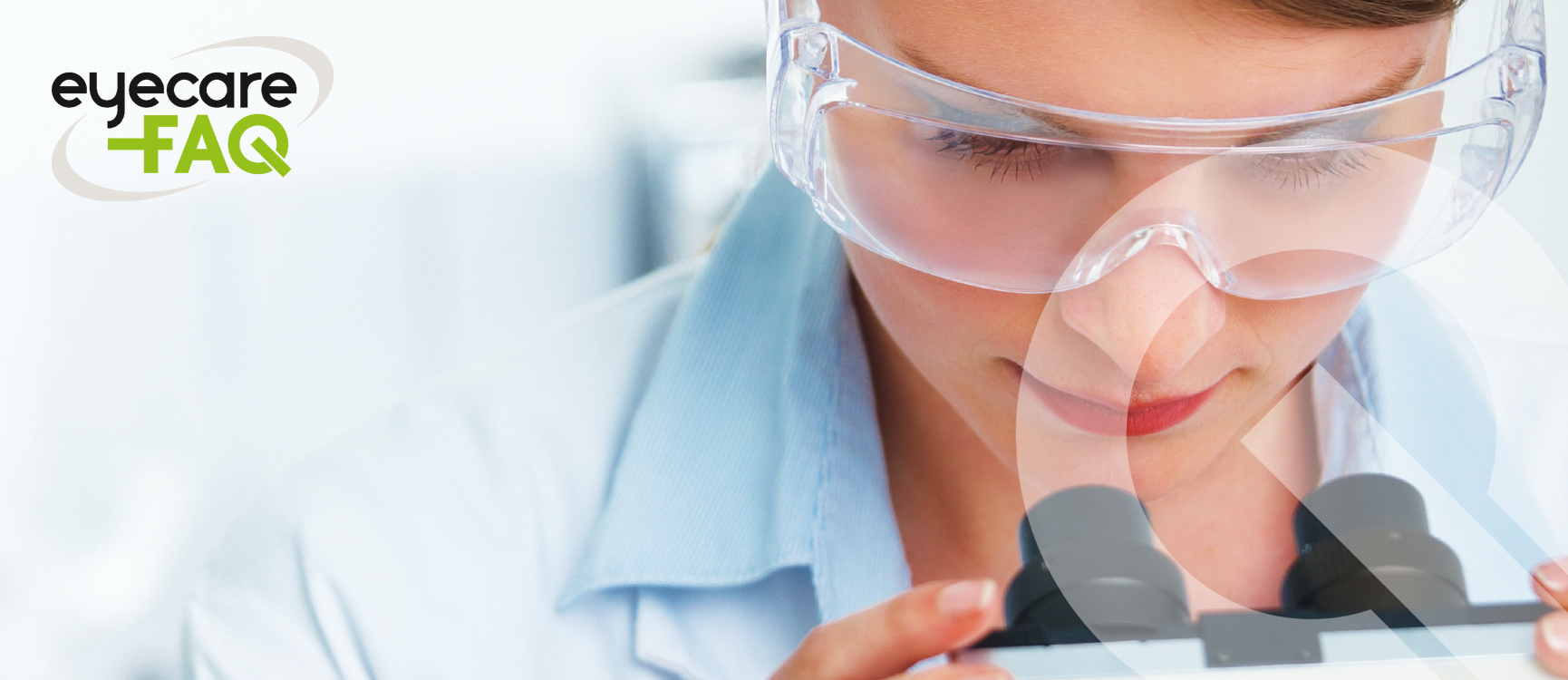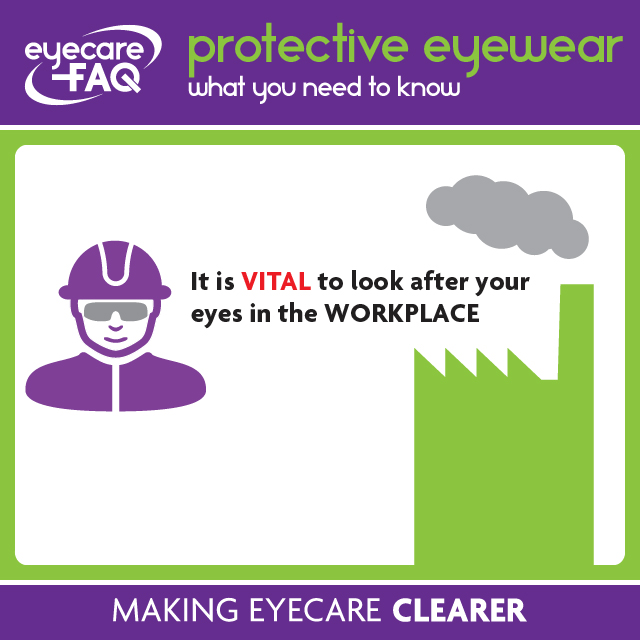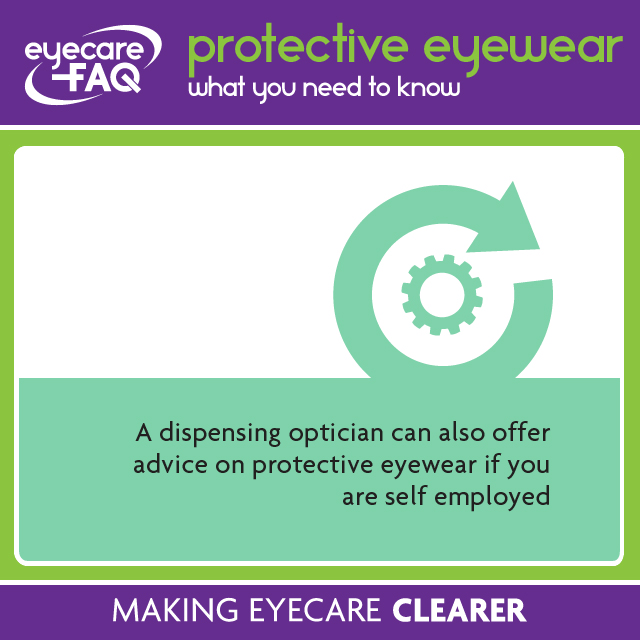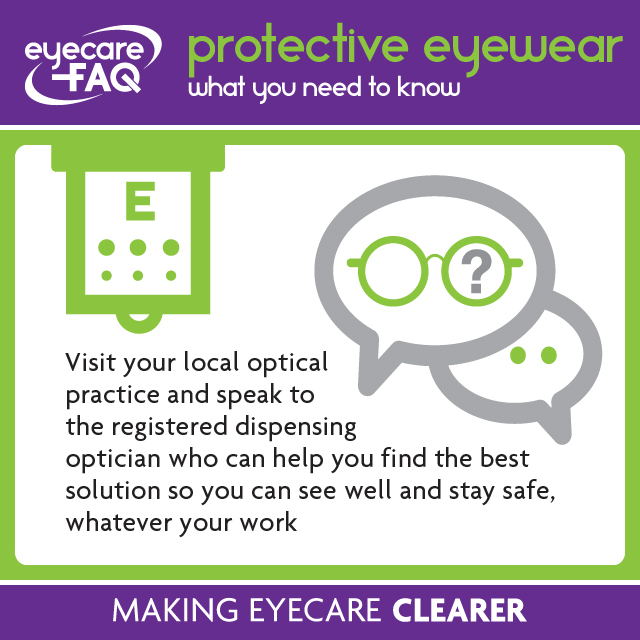What sort of eye protection do I need for my job?
There are Health & Safety laws to ensure that you are safe and protected when doing your job. All safety specs and goggles must comply with British and European Standards EN166, and there are different types of protection depending on the job you do. Some safety specs will stand up to impact while others are designed to resist heat, for example.
Health & Safety at Work Regulations require your employer to identify and evaluate workplace risk. This is commonly undertaken by the company safety officer. You may be then asked to go to a registered dispensing optician for the required protective eyewear to be measured, ordered and fitted.
What about if I’m self-employed?
If you are self-employed a dispensing optician should perform a detailed assessment of your requirements and the type of hazards that are associated with your day to day work. They may speak to a specialist supplier for advice.
Safety spectacles should always come from a recognised safety eyewear manufacturer to ensure that the necessary standards are met, the frame and lenses will have a British Standards Kite Mark stamped on them and certificate is issued to show that they conform to that Kite Mark.
How do I protect my eyes at work?
If you work outdoors you may need to protect your eyes from hazards like grit and dust as well as from regular exposure to UV light. Whether you are a gardener, traffic warden, police or road worker, specialist lens options, such as photochromic lenses, can help working outdoors more comfortable.
When photochromic lenses are exposed to ultraviolet rays they darken and provide visual comfort in direct sunlight. The depth of tint will vary depending on the extent of the light and the outside temperature. The depth of tint fades when moving out of the direct sunlight returning to almost clear at night and indoors. You can work wearing photochromic lenses without changing spectacles, a big benefit. Some photochromic lenses are available in Trivex and polycarbonate material if you also need impact protection.
If you work in a more hazardous setting there are laws to ensure that your employer takes safety seriously. Depending on your role, you may be required to wear protective eyewear, either all the time or when on the factory floor. Safety eyewear can be prescription or non-prescription and come in a variety of options including spectacles, goggles and shields.
Safety spectacles have side shields attached to the side of the frames to avoid any foreign objects entering the eye and surrounding area and it is likely that the lenses supplied will be plastic (thickened CR39), toughened glass (thermally or chemically), low energy impact materials, or materials such as Polycarbonate or Trivex.
Ask your registered dispensing optician for advice on the right eye protection for you.
How do I look after my safety specs / protective eyewear?
Never try to adjust or repair safety specs yourself. Clean them carefully as advised. If they show signs of wear or damage, return to the practice that supplied them to you. It can be worth having a second pair. Damaged safety specs will not protect your eyes.
How do I stop glare?
Glare can affect eyesight in various ways. Distracting glare can be caused by car headlights or streetlights at night, or by light being reflected off the front surface of spectacle lenses making it difficult for others to see the wearer’s eyes. Similarly, it may be from light reflected off the back surface (ie the inner side) of the lenses, so that the spectacle wearer sees the distracting reflection of their own eyes and objects behind them when looking forward. This kind of glare may cause eye fatigue, annoyance and distraction. Discomforting glare can be caused by every day, normal sunlight conditions, regardless of weather or time of day. It can be present when moving from one lighting condition to another and may cause ‘squinting’ and eye fatigue. Disabling glare comes from excessive, intense light that can occur when facing the sun, of from light reflected off smooth, shiny surfaces such as water, sand or snow. Disabling glare can block vision because the intense light can cause significantly reduced contrast of the retinal image. To diminish the effects of blinding or reflected glare it is strongly advisable to wear polarising filter lenses to counteract the reflected light. Polarised lenses reduce the amount of light passing through the lens by selective filtering.
How well do I need to see to become a train driver?
Train drivers will almost certainly be driving in differing climates and light conditions, so need to cover all eventualities. In terms of visual acuity, the train driver will be required to have visual acuity of 6/9 in the better eye and 6/12 in the other eye – similar to the requirements for a car driving license – with near vision acuity of N8. You can’t become a train driver if you have a colour vision deficiency. Train drivers should have a clear pair of spectacles, with a multi-anti-reflection coating, with an additional pair with tinted lenses.
Can I wear glasses and still be a pilot?
Yes, but this depends on specific visual requirements so not all spec wearers can be a pilot. The entry requirements vary between commercial and private pilots but can require a visual acuity, with spectacles or contact lenses, to be 6/9 in each eye with an ability to see 6/6 binocularly- patients are recommended to contact the CAA for details. VA’s can be checked at a routine eye test. Additionally, there should be no anisometropia or astigmatism of more than 2.00 dioptres.
Pilots should carry a spare pair of spectacles at all times.
What are the best spectacle tints or sunglasses for pilots?
Sunglasses are an important piece of protective equipment in the cockpit. The tint should be neutral in colour, generally grey or brown are acceptable. The tint should be no darker than 80% absorption. It can also be beneficial to consider a graduated tint, whereby the lens is tinted at the top and reducing in depth of tint at the bottom.
Polarised lenses reduce the amount of light passing through the lens by selective filtering of certain electromagnetic spectral planes. These lenses can cause distortion patterns from certain toughened cockpit windshields. However there have been advancements in technology whereby the axis of the polarising filter has been specifically controlled to ensure visual recognition is not hindered allowing pilots to use if they so wish.
Light travels in all different directions, oscillating, which causes glare. When a polarised filter is introduced the light travels in one direction, p-state light. Polarising filters block or reduce light reflected at certain angles from smooth, non-metallic surfaces such as glass or water, thus reducing the effect of glare to the wearer.
I drive for work. How well do I need to be able to see?
For ‘Group 2’ drivers eg those individuals who drive large goods vehicles, lorries, buses etc. the vision in the good eye must be at least 6/7.5 and at least 6/60 in the other eye. Where glasses are worn to meet the minimum standards, they should have a corrective power ≤ +8 dioptres. The uncorrected acuity in each eye must be 3/60. The minimum field of vision for safe driving is defined as a field of at least 120° on the horizontal and the extension should be at least 50° left and right. In addition, there should be no significant defect in the binocular field which encroaches within 20° of fixation above or below the horizontal meridian. This all sounds quite technical, and you need to seek advice from an optical professional to discover if you meet the required standards. Book at eye test, and attend every two years or more often if recommended.
Find out more about driving and your eyes here.
How should I protect my eyes when doing DIY?
Always protect your eyes when doing DIY. You could damage your eyes if there are flying particles or dust, whether you are drilling, using a hammer or chisel. Chemical compounds, everything from ammonia to acids to even super glue can harm your eyes. Did you know there are more accidents in the home than at work?
If you don’t need specs pick up some ‘wrap around goggles’ made from injection moulded Polycarbonate. These are widely available from a few quid so there is no reason not to have a pair with your tools.
If you wear specs, you may be able to find goggles that fit over the top, or call in and speak to a registered dispensing optician for advice.
I work in a factory. What eye protection do I need?
Whether you are an engineer, a cleaner or a craftsman, you may work in a factory. Danger can arise from a number of places and situations in your work setting, and there are laws to ensure that your employer takes safety seriously. Depending on your role, you may be required to wear protective eyewear, either all the time or when on the factory floor. Safety eyewear can be prescription or non-prescription and come in a variety of options including spectacles, goggles and shields.
Safety spectacles have side shields attached to the side of the frames to avoid any foreign objects entering the eye and surrounding area and it is likely that the lenses supplied will be plastic (thickened CR39), toughened glass (thermally or chemically), low energy impact materials, or materials such as Polycarbonate or Trivex.
Get advice from a registered dispensing optician or from your company safety officer.
I work in an office, what do I need to do to look after my eyes?
When you work in an office your eyesight can be vital for your job. If you spend all day using a computer, you may benefit from specs that are specifically set to focus on the screen. Looking after your vision at work isn’t just about having the right specs. Everyone is different in height and posture, so the first thing to do is work out whether your screen is positioned correctly for you. You also need to consider whether you get glare from lights or window reflections on your screen, putting strain on your eyes. Working at a computer, you should take regular breaks. Prolonged use can lead to staring and potentially dry eyes as a result of insufficient blinking.
If you have not had an eye test in the last couple of years and you work in an office, do book an appointment. Explain to the optometrist about the sort of work you do and they can offer you advice, and help you discover whether specs can help you.
Talk to a registered dispensing optician when it comes to choosing specs for work. Some lenses are better than others for computer use and the optician can advise. Remember to ask about anti-reflection coatings as these can help to cut glare.
Find out more about computers and your eyes here.
What is the best sort of eye protection for outdoor work?
If you work outdoors you may need to protect your eyes from hazards like grit and dust as well as from regular exposure to UV light. Whether you are a gardener, traffic warden, police or road worker, specialist lens options, such as photochromic lenses, can make working outdoors more comfortable.
When photochromic lenses are exposed to ultraviolet rays they darken and provide visual comfort in direct sunlight. The depth of tint will vary depending on the extent of the light and the outside temperature. The depth of tint fades when moving out of the direct sunlight returning to almost clear at night or indoors. You can work wearing photochromic lenses without changing spectacles, a big benefit. Some photochromic lenses are available in Trivex and polycarbonate material if you also need impact protection.
How do I protect my eyes at home?
In everyday life, a good pair of spectacle lenses won’t just help you see better. They will protect your eyes too. Talk to your dispensing optician about lens coatings which resist smudges, dust, scratches, glare and repel water. You should also think about protecting your eyes against UV light on a daily basis.
Find out more about spectacle lenses here.
How do I protect my eyes on holiday?
If you are off to sunnier climes, have you thought about protection from UV light? Don’t just slap on the sunscreen: also remember to pack a pair of sunglasses. It’s not advised to put sunscreen on or near your eyes and lids, so your sunspecs are the only protection that your eyes have. Sunglasses need to fit your face well in order to be effective at stopping UV light, so make sure that you get advice when choosing. Always look for the CE mark when buying lenses. Speak to a registered dispensing optician for advice on prescription sunglasses and fitting.
Find out more about sunglasses here.




